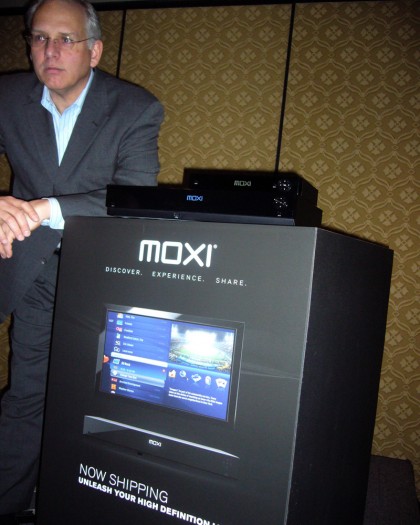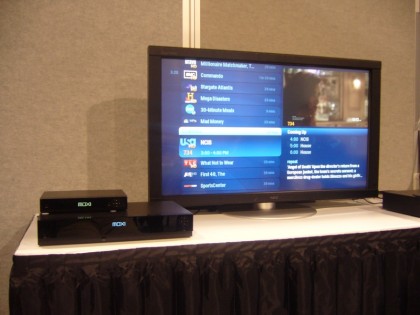
Although units began shipping in mid-December (with little fanfare), Digeo CEO Greg Gudorf officially unveiled their long delayed and re-imagined retail Moxi HD DVR ($800) last week at CES. I’ve previously been critical of Digeo’s go-to-market and press/blogger outreach strategies, but I’ve never had a problem with their tech – in fact, the Moxi OS was ahead of it’s time. Making these delays all the more frustrating. So, it’s good to finally see a solid offering available on store shelves. Err, available solely at Amazon.com. In fact, I bet DVR pioneer TiVo is happy to see a bit of competition. Hopefully raising awareness amongst consumers that they’re not limited to cable-co provided set-top boxes. Which is the big challenge facing these guys… After 9 years on the market, while DVR household penetration has skyrocketed, TiVo has fewer than 2 million stand-alone subscribers. In fact, Gudorf pretty much began his talk by proclaiming the Moxi HD DVR is “not a mass market product” – rather, it’s a “premium” offering targeted at 12-15 million digital cable customers.

The Moxi experience is largely unchanged from the demos I’ve attended and the pre-release unit I had in my home back in 2007. The rich, graphical UI is now completely HD, and retains the dual axis navigation. Which in many ways is efficient, but cluttered in others. I still dig the Super Ticker which scrolls Internet-acquired info (weather, scores, etc) along the bottom of your screen like CNN or ESPN. Moxi offers a ton of programming filters, perhaps too many, and provides real-time web-based scheduling and conflict management. A variety of Internet content is accessible from the box, including info/news, Flickr, and Finetune (music). Additionally, you can access your personal MP3s or JPEG images from a Windows PC – with true DLNA support slated for later this year. However, at least initially, Moxi doesn’t have a video on demand partner like an Amazon, CinemaNow, or Netflix. But it’s probably safe to assume movie downloads are on the road map. Moxi provides some advanced functionality not seen on TiVo, such as being able to manually map clear QAM channels. But, on the other hand, the ability to offload video (à la TiVoToGo) is not present.